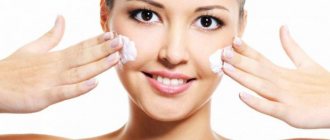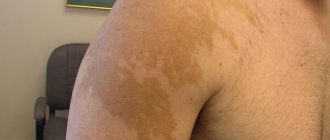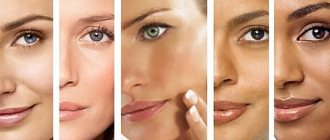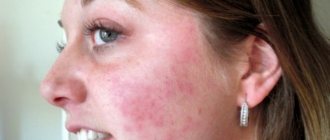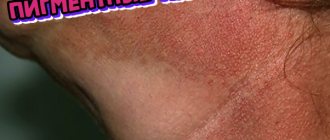Cosmetologists are noticing a disappointing trend: the number of people suffering from hyperpigmentation is steadily growing. We can safely say that hyperpigmentation is the scourge of our time.
Despite the fact that pigment spots do not affect a person’s health in any way or affect their lifestyle, they are a serious aesthetic defect that causes a person great psychological discomfort. Pigmented areas on the face create an unattractive appearance and can be the cause of some serious diseases. In addition, any cosmetologist knows how difficult it is to remove age spots and return a uniform color to the face.
What it is
Hyperpigmentation
- This is an excessively intense coloring of certain areas of the skin compared to the color of the rest of the skin. Different nationalities have different skin colors - this is due to the amount of pigment they receive and which is evenly distributed throughout the skin. That’s why the shades are so different – from dark brown to white. For example, under the African sun there live people with dark, almost black skin. But in countries where the sun is neutral or does not pamper local residents so often, people have snow-white skin. If there is no melanin at all, the skin becomes almost transparent and does not retain the sun's rays. We call such people albinos precisely because of the unusual color of their skin.
Kinds
- Chloasma
- These are pigment spots that appear during pregnancy. Externally, they can be different - from pale yellow to brown, the shape is often round. They affect the face around the eyes and on the sides of the cheeks.
- Melasma
– pigment spots that can spontaneously appear in anyone. They come in different colors - from light brown to intense brown. They are located symmetrically on the face and neck.
- Lentigo
– hyperpigmentation that occurs in older people. The spots appear against the background of loss of pigment in other areas of the skin and have a characteristic dark brown color.
- Ephelides
– freckles – stand alone. They appear in people in the spring, and in winter they can disappear completely. They are more common in red-haired people due to the peculiarity of their skin, which unevenly accumulates pigment.
What is the reason?
The reasons for the disruption of the process of accumulation and distribution of color-forming pigments lie in their increased synthesis, which in most cases is caused by various diseases of the endocrine glands, liver and bile ducts. In addition, an increase in melanin in the skin is observed in metabolic pathologies, pregnancy and vitamin imbalance. The disease can be triggered by bruises, increased sensitivity to ultraviolet rays, as well as taking certain medications (antibiotics, salicylates, products based on St. John's wort extract, etc.).
Where does hyperpigmentation come from?
When people experience hyperpigmentation, they immediately start searching for information online. There is really a lot of data on the causes of hyperpigmentation, which, as a rule, lists disorders and diseases of almost all body systems. For example, problems with the body's endocrine system. Is it true? Is it true. And the fact that disruption of the gastrointestinal tract and intestines in particular can lead to hyperpigmentation disorders? This is true. Do adrenal gland dysfunctions lead to this? They bring you.
If you look at the whole system from the outside, it turns out that pigmentation disorders on the skin can arise due to almost any problem in the functioning of the body
. Most often, spots appear on the face, neck and open areas of the body. And they arise for one reason - if the body has problems, it reacts to external stimuli differently than the body with which everything is fine. Therefore, when you come to the doctor with such a problem, he immediately suggests checking the entire body to find out the cause. This is a standard solution, because everything has triggers. But not all people with kidney damage have pigmentation disorders. Not all people with gastrointestinal disorders have spots on their faces. Therefore, it is necessary to study why hyperpigmentation affects each individual patient.
Another reason is helminthic-protozoal infestations. This is a common problem, because we all keep different animals in the house, and we do not always observe personal hygiene measures. Infection with helminthic-protozoal infestations greatly contributes to the occurrence of hyperpigmentation.
Many even give credit to psychological reasons. For example, experts say that if a woman develops pigment spots around her eyes, this is due to a depressing factor in her life - the influence of her husband, problems with relatives... In this case, hyperpigmentation is interpreted as an attempt to hide by disguising her appearance. Think. this has a certain meaning, although not so literal.
Competent healers say that vitiligo is the result of a fright experienced in childhood, but psychologists who work according to the Western system cannot cure this process. They manage to compensate for the patient’s psychological state, but they are not able to “get” the result of this fear. And, of course, people actively use the “institute of grandmothers”, which, with the help of their techniques, get rid of hyperpigmentation. Indeed, there are patients who have achieved complete regression of the disease. I guess what’s strange to hear from a specialist who adheres to traditional (and sometimes not so traditional) medicine, is that it exists.
Non-senile pigmentation
Pigment spots... Yellowish, light brown, reminiscent of ripples - this is not a sign of age at all. This is a cosmetic defect. So this problem can not only be solved, but it is even necessary, necessary. Especially when such a problem arises at the age of forty, and not after eighty.
Rejuvenation of pigmentation has become possible thanks to the widespread fashion for tanning. Another reason is hormonal changes. Therefore, to ensure that the problem does not manifest itself for as long as possible, it is imperative to monitor your health.
Improper functioning of the defense mechanism causes increased melanin production. This is the price to pay for loving a deep tan. It is much easier to prevent the appearance of hyperpigmentation than to get rid of it later. Taking vitamins, timely examinations, and protecting the skin from the sun are steps that help prevent the early appearance of age spots.
Most often they appear on the skin of the hands and face. These areas require special attention. After taking medications prescribed by a doctor, melanin production slows down, the spots lighten and disappear.
Sun protection
To prevent the development and formation of hyperpigmentation in people of any age and skin type, it is necessary to use sunscreen and avoid direct sunlight, especially during maximum solar activity - from 11 a.m. to 4 p.m. UVA rays should be avoided before and after peelings, laser hair removal, and plastic surgery; while taking hormonal contraceptives, antibacterial and other medications, as well as during pregnancy.
The skin's tendency to hyperpigmentation is increased by certain substances and cosmetics that increase the skin's sensitivity to UVR (ultraviolet radiation) - photosensitizers (substances that become an allergen under the influence of UV radiation). Before starting active sunny days and a course of procedures to remove age spots, you must consult with a specialist about all cosmetics and medications that you use in order to avoid complications.
Sunscreens are cosmetic products that contain substances that absorb or reflect UV radiation. The SPF value shows how much the biodose of protected skin exceeds the biodose of unprotected skin. This indicator only indicates the effectiveness of protection against UV radiation. The SPF indicator is relative. For people with different skin phototypes, it makes it possible to stay in the sun for a certain time, which is subtracted according to the formula, without harm to health.
Dr. Barbara Sturm Brightening Face Lotion
Best for: Sun spots and post-inflammatory hyperpigmentation
This moisturizer for dark spots softens, evens out skin tone and makes it glow. The lotion will be especially appreciated by those with sensitive skin, as it does not contain parabens and sulfates, as well as oily skin, since it has the lightest texture and does not leave marks after drying.
Besides vitamin C, its formula does not contain classic ingredients commonly found in hyperpigmentation products. Instead, it includes a blend of vitamins C and E, watercress sprout extract (for sun spots), ginseng extract (to fight free radicals) and hyaluronic acid (for hydration). If you need long-term benefits, and not a quick solution, take it into service.
Eve Lom Brightening Cream
Best for: Dark spots and post-inflammatory hyperpigmentation
A lightening cream for age spots, developed by the face care specialists of the Eve Lom brand. It contains a Korean-patented Dermapep complex that blocks melanin production and is 20 times more effective than its skin-lightening competitors arbutin and kojic acid. The product gives the first results within a week of use - the epidermis becomes brighter, lighter and smoother. Bonuses: soothing rose scent + always hydrated and silky skin.
The Best Vitamin C Serums That Work Great for Skin
Treatment
In principle, there are no medical indications for the treatment of PIH; this condition does not pose any threat to health. Moreover, in most cases, the degree of pigmentation weakens over time, and after a few months the spot disappears. However, since many patients are concerned about cosmetic defects, treatment for hyperpigmentation may be prescribed.
First of all, a patient who is concerned about PIH is advised to constantly use sunscreen. Without this condition, any treatment for PIH will be ineffective.
It is necessary to use both mechanical (wearing closed clothing, wide-brimmed hats, glasses) and chemical (creams, lotions) protective equipment.
To treat the manifestations of PIH, local remedies are used - creams, lotions, ointments containing substances that whiten the skin. These substances include the following.
Hydroquinone. This substance gives the best effect in the treatment of hyperpigmentation. However, this substance must be used with caution, as it has a toxic effect on the body. The higher the concentration of hydroquinone in the cream or ointment, the more pronounced the whitening effect the product has. However, as the concentration of hydroquinone increases, the toxic effect of the drug on skin cells also increases. Typically, products containing about 2% hydroquinone are used to treat PIH. As prescribed by a doctor, products containing 4% of the active substance can be used. The use of products containing hydroquinone is strictly prohibited for pregnant women and children.
Kojic acid is a substance that has an exfoliating and whitening effect. The disadvantage of this product is that it is allergenic, so before using creams with kojic acid, you must do a test by applying a little product to the skin of the elbow. If the skin is red and inflamed, do not use the product.
Arbutin is a substance that has an inhibitory effect on melanin production without having a toxic effect on skin cells, including melanocytes.
Azelaic acid has a whitening and anti-inflammatory effect on the skin. It is less toxic, but also less effective than hydroquinone.
To treat PIH, bleaching agents should be used as prescribed by a doctor. During use, you must carefully monitor your skin's reaction. If signs of irritation or inflammation appear, you must immediately stop using the cream or ointment, otherwise hyperpigmentation may worsen.
Treatment with traditional methods
Traditional methods can also be used to treat PIH. Folk remedies are less effective than medications, but they are also safer.
- To combat PIH, you can use freshly collected birch sap. Apply the juice to dark spots 5 times a day, allowing it to dry. The collected juice can be stored in a tightly sealed container in the refrigerator for up to 3 months.
- Celandine will help cope with PIH. To treat hyperpigmented spots, apply grass juice. In winter, instead of fresh juice, you can lubricate the stains with tincture of the plant.
- Yeast masks have been successfully used to treat PIH. Fresh yeast should be diluted with pharmaceutical hydrogen peroxide (3%) until a creamy mass is obtained. Apply the mixture to the stain and leave until completely dry. Then wash it off.
- Strawberries give a good whitening effect. The juice of the berries is used to lubricate areas of post-inflammatory pigmentation. You can use the juice from sauerkraut in a similar way.
- A good remedy to combat hyperpigmentation is pumpkin seeds. The peeled seeds are ground into a paste, diluting the resulting mass with a small amount of water. Apply to hyperpigmented spots like a mask. The procedure is done daily.
Prognosis and prevention
The prognosis for complete removal of stains from PIH depends on the depth of the pigment. With epidermal hyperpigmentation, the spots disappear after a few weeks. If the pigment lies in the dermis, the stain can persist for years, sometimes it persists throughout life.
Prevention of the development of PIH involves reducing exposure to sunlight on the skin, timely treatment of inflammatory skin diseases, and avoiding injuries. When carrying out cosmetic procedures associated with skin damage, you need to especially carefully protect the skin from sunlight.
Diagnostics
A standard diagnostic program may include the following:
- a thorough physical examination and general history;
- general and biochemical blood test;
- general urine analysis;
- microscopic examination of feces;
- Ultrasound of the abdominal organs;
- tests for dysbacteriosis;
- hormone analysis, etc.
The exact diagnostic program is determined only by the attending physician. The initial examination is carried out by a dermatologist. If necessary, an endocrinologist or gastroenterologist can be involved in treatment. If hyperpigmentation of the facial skin occurs during pregnancy, you may need to consult a gynecologist.




